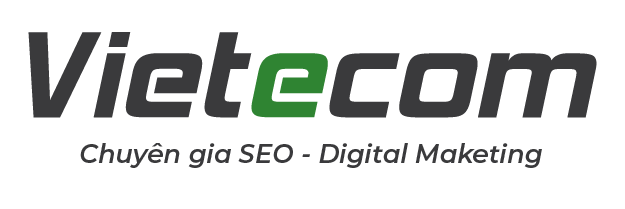SEO professionals know that staying organized is key to success.
With campaigns getting more complex, the right project management tool can make or break your productivity.
This article examines various project management platforms suited for SEO teams. We’ll discuss how these tools can help plan, track tasks and time, manage resources, and report results.
We’ll compare the pros and cons of each tool, from heavy hitters like Asana to SEO-specific options like Forecast.
You’ll get insider tips on using these platforms to streamline your SEO workflows, whether you run a small team or manage large campaigns.
Let’s find the perfect tool for your needs.
Why SEO Professionals Need Project Management Tools
Project management platforms boost efficiency for digital marketers and web teams. If you’re not using one, you’re missing out on serious productivity gains.
Key benefits for SEO pros include:
- Comprehensive planning: From campaign overviews to granular keyword performance.
- Task and time tracking: Streamline workflows and improve billing accuracy.
- Resource management: Monitor budget allocation across SEO and PPC efforts.
- Reporting: Leverage data-driven insights to boost productivity.
Choosing the right PM tool can be challenging, given the wide range of options.
We’ve curated a list of the top platforms, complete with pros and cons, to help you make an informed decision.
Our Top 15 Project Management Platforms For SEO
1. Asana
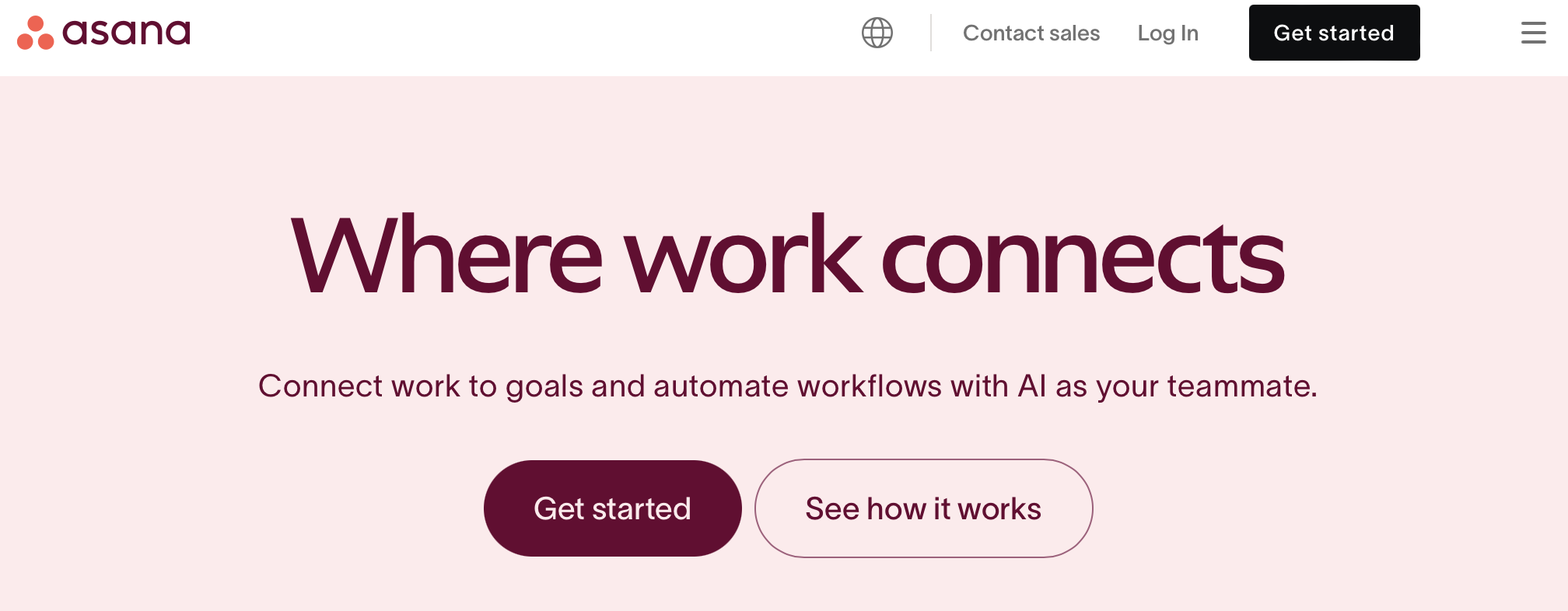 Screenshot from Asana.com, August 2024.
Screenshot from Asana.com, August 2024.Asana streamlines SEO project management with exceptional task organization and collaboration features.
Its user-friendly interface helps break down complex campaigns, set deadlines, and monitor progress. Custom fields allow adding SEO-specific data, such as target keywords or search volume, to tasks.
The Board view is excellent for visualizing SEO workflows. You can create columns for each stage (e.g., keyword research, content creation, on-page optimization, link building) and quickly move tasks between them, offering a clear project overview.
Why It’s Good For SEO:
- Task management: Using the forms feature, you can create standard workflows customized to your SEO processes.
- Automated workflow: Rules-based automation can replace tedious manual tasks.
- Reporting features: Asana has dashboards, charts, and graphs with real-time reporting, so you can get a high-level view or dive into the details.
- Free for up to 15 users: Asana has a free tier for teams of 15 or fewer. It includes unlimited tasks, messages, projects, and 100MB of storage for each user.
- Integrations: Asana plays nicely with over 100 other apps and platforms, including Microsoft Office, Dropbox, and Salesforce.
Potential Drawbacks For SEO:
- Unintuitive design: If you’ve never used Asana before, it can be challenging to figure out. However, once you’ve mastered the learning curve, it’s pretty easy to use.
- No time tracking functionality: This platform doesn’t have built-in time tracking functionality, which can complicate billing clients or resource allocation.
- Not ideal for small teams: Its range of advanced features and capabilities can be overwhelming for small teams or limited SEO projects.
Tips and Tricks:
- Create task templates with “Forms” to capture all essential SEO data.
- Use the “Timeline” view for big-picture SEO strategy planning.
- Prioritize personal SEO tasks across projects with the “My Tasks” view.
Best Hack:
- Add a custom “SEO Impact” field (High/Medium/Low) to tasks. Use it to rank SEO activities by potential SERP influence. Create a saved filter for “High Impact” tasks across projects to focus on top-priority SEO work.
2. Monday.com
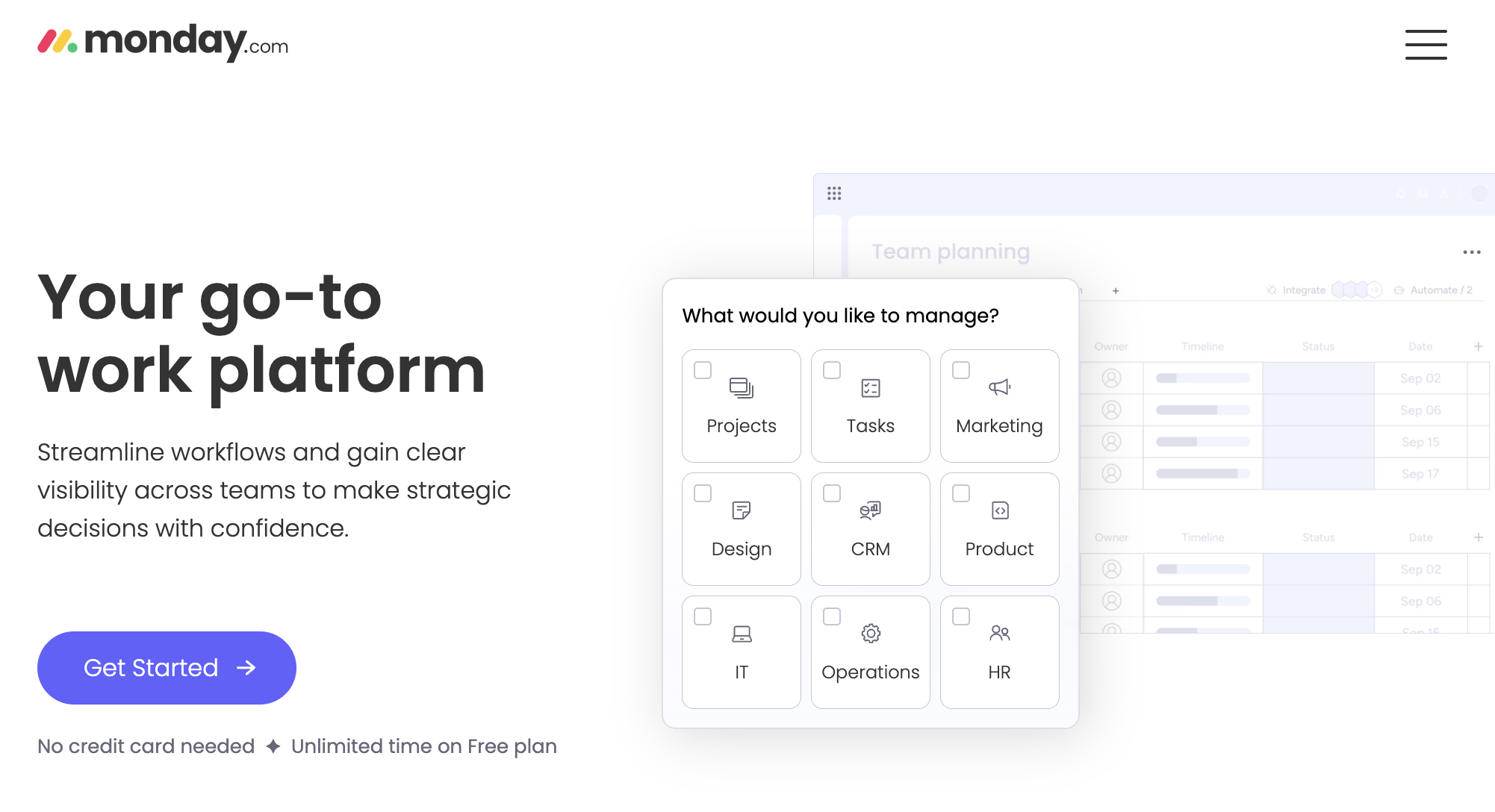 Screenshot from Monday.com, August 2024.
Screenshot from Monday.com, August 2024.Monday is a visual, flexible project management tool that adapts well to SEO workflows. Its key strengths are custom views and automation, which can reduce repetitive SEO tasks.
In practice, I’ve used it for SEO audits. I set up a board with columns for audit areas (tech SEO, content, backlinks) and rows for each page. Color-coding highlighted urgent issues, while number fields tracked progress scores.
Why It’s Good For SEO:
- Clean user interface: Monday.com has a clean interface that allows you to customize your dashboard and extend data in columns. You can quickly get multiple views of an SEO project, including calendars, Kanban boards, and collateral.
- Templates: Monday.com offers many templates, so you will likely find one that matches your workflow.
- Notifications and communication: This platform streamlines team communication. Team members can leave comments on tasks or documents, and stakeholders can be notified via email.
Potential Drawbacks For SEO:
- Steep learning curve: Like many PM platforms, Monday.com can be challenging to learn. Bigger tasks with more communication can begin to become unwieldy.
- Slow dashboard loading: Your Monday.com dashboard can take some time to load, particularly on larger projects where a lot of data has to be transferred from its servers to your computer.
- Client licenses not included: If you want to invite clients to participate in your workspace, you will need to buy a license for them.
Tips and Tricks:
- Leverage the “Formula” column for auto-calculated metrics. Combine page speed and content quality to create custom SEO health scores.
- Use “Time Tracking” to gauge task duration. It helps with resource planning and client invoicing.
- Organize SEO docs (keyword research, content briefs) in the “Files” view for quick access.
Best Hack:
- Automate task creation in your “Content Calendar” board when “Keyword Research” tasks are completed. Pull in key details like target keyword and search volume. This streamlines the workflow from keyword discovery to content production.
3. GanttPro
 Screenshot from ganttpro.com, August 2024.
Screenshot from ganttpro.com, August 2024.GanttPro excels at visualizing SEO project timelines. Its drag-and-drop interface makes it easy to adjust task durations and dependencies, which is vital for adapting to SEO campaign fluctuations.
In practice, I found GanttPro useful during a site migration. Setting task dependencies (like “Update Internal Links” after “Create 301 Redirects”) helped avoid critical errors during the process.
Why It’s Good For SEO:
- Readily understandable: You don’t have to have a project management certificate to track tasks with GanttPro. It gives you status information in an easy-to-understand visual format.
- Undo functionality: A simple mistake doesn’t have to derail your project because this tool saves your history and lets you undo actions with CTRL + Z.
- Customizable fields: You can create custom fields for every task.
Potential Drawbacks For SEO:
- Not as many integrations: Unlike other PM platforms, GanttPro is light on integrations with other apps.
- No billing or invoicing tools: You will need an outside program to generate invoices for your SEO services.
- Manual date input: Changing dates for benchmarks and project completion must be input manually, which some users find tedious.
Tips and Tricks:
- Use “Critical Path” to spot key tasks for on-time project completion. It helps prioritize and keep you on track.
- Balance team workload with resource management tools.
- Compare progress to the initial plan using “Baseline” for better future estimates.
Best Hack:
- Make a template Gantt for common SEO projects (audits, link building, etc.). Include standard tasks, durations, and dependencies—clone and tweak for new projects to save setup time.
4. Trello
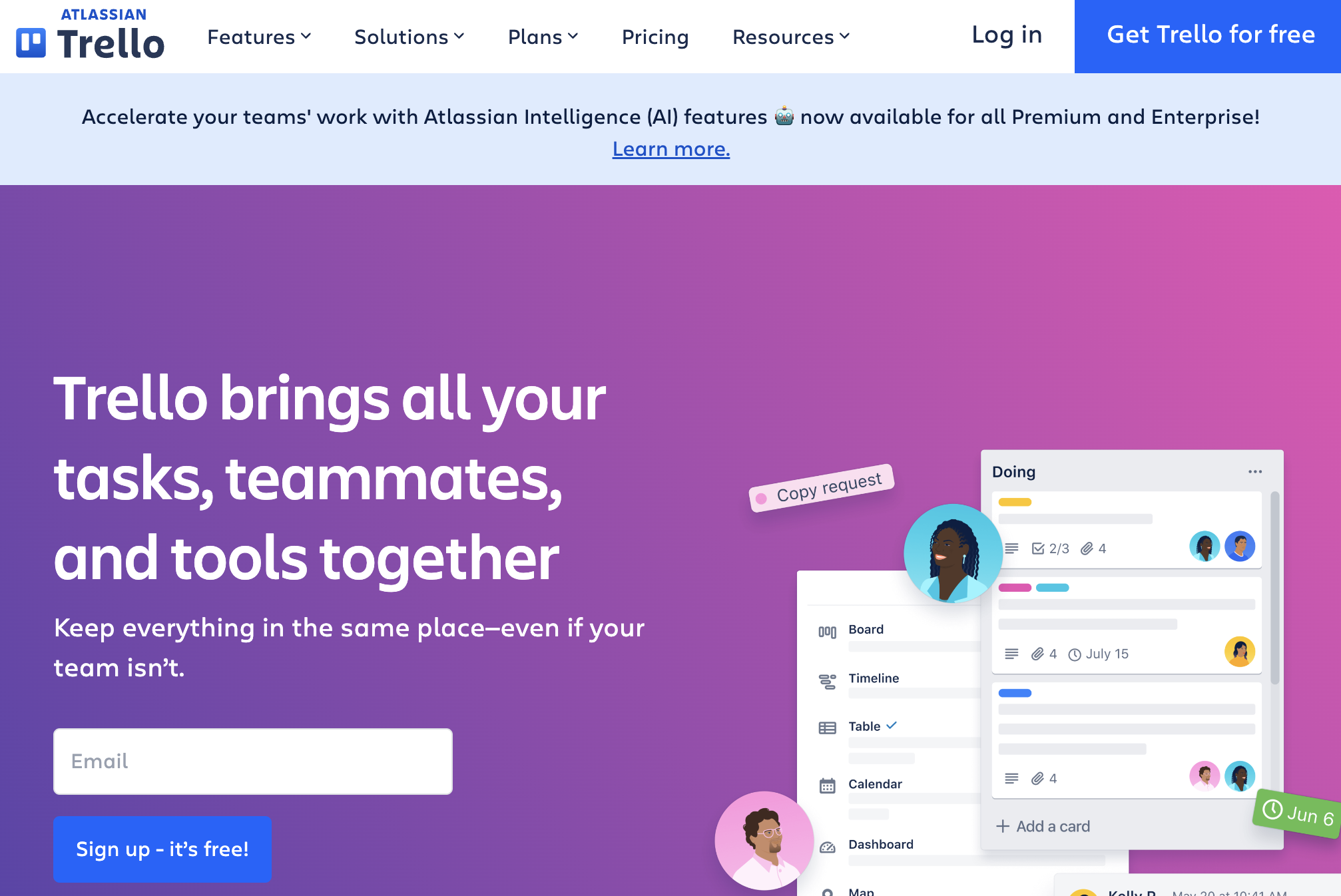 Screenshot from trello.com, August 2024.
Screenshot from trello.com, August 2024.Trello excels in simplicity and adaptability. Its Kanban boards are ideal for SEO workflows, from content to link building. Power-ups boost functionality for specific SEO tasks.
In practice, I’ve used Trello for content optimization. Cards moved through lists like “To Optimize” to “Published,” with labels for content types and checklists for SEO best practices.
Why It’s Good For SEO:
- Free basic plan: Your entire team can try Trello for free. If you like it, premium plans that add integrations, automation, and other functionality are available.
- Intuitive Kanban boards: Trello’s drag-and-drop card system makes it easy to track the status of any project.
- Useful for campaigns of all sizes: Trello is just as effective for complex campaigns as it is for simple projects.
Potential Drawbacks For SEO:
- Kanban-reliant: If you dislike using Kanban boards, this is not the PM tool for you, as most of its functionality is built around them.
- Upload sizes limited: Trello restricts free users to 10 MB of online storage and paid users to 250 MB. This probably won’t be a problem for most SEO teams, but you may differ.
- Timeline relationships are not always clear: Trello doesn’t allow users to manipulate relationships to better understand how they work together.
Tips and Tricks:
- Use “Calendar” to visualize the content schedule.
- Add SEO info to cards with “Custom Fields.”
- Set up recurring tasks with “Card Repeater”
Best Hack:
- Connect Google Sheets to Trello via Zapier. New rows in your team’s “Content Ideas” sheet will auto-create cards in Trello, streamlining idea collection.
5. Teamwork
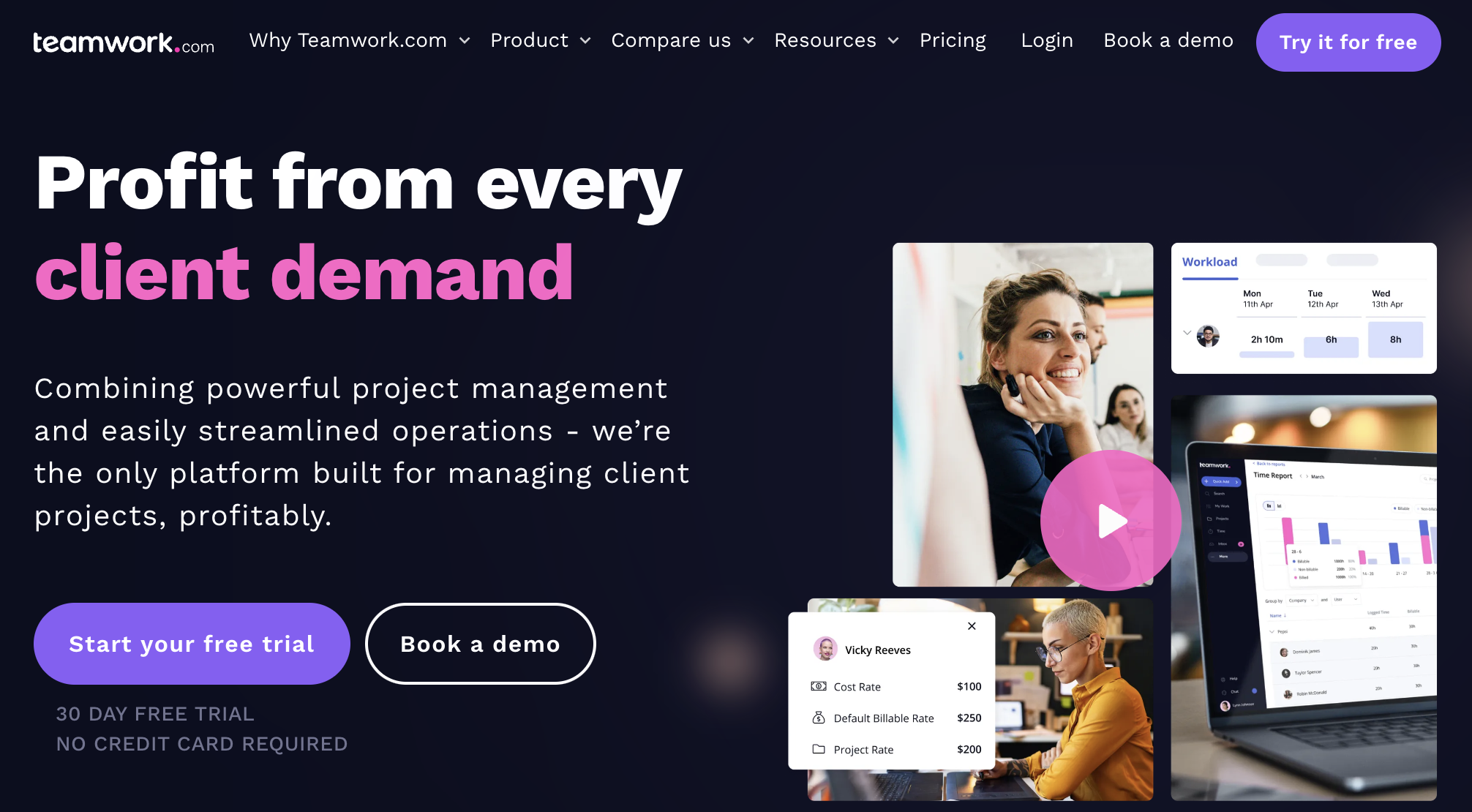 Screenshot from teamwork.com, August 2024.
Screenshot from teamwork.com, August 2024.Teamwork is a solid project management tool for SEO teams, perfect for big, complex campaigns. It handles multiple client projects simultaneously and has features for time tracking, task management, and team collaboration.
I used it for a content marketing push across several client sites. Using the project template feature, we created a standard workflow for content creation, from keyword research to publication. This kept our process consistent and saved loads of setup time.
Why It’s Good For SEO:
- Unlimited users: You can add users to a single task.
- Clear vision of scope: Teamwork’s board view makes it easy to understand what is going on with each project.
- Repeating tasks: Teamwork lets you copy any task, which is especially useful for SEO professionals.
Potential Drawbacks For SEO:
- Can be overwhelming: Teamwork has many features. The downside is that all those features can get confusing, especially for new users.
- No in-platform chat functionality: You’ll need to use an outside app to “chat” with your team and/or stakeholders.
Tips and Tricks:
- Use “Board View” for daily tasks and “Gantt Chart” for long-term planning.
- Leverage “Workload” to balance SEO team efforts.
- Implement a “Risk Register” to monitor potential SEO roadblocks (e.g., algo updates, competitor moves).
Best Hack:
- Create a custom dashboard with widgets showing key SEO KPIs across client accounts, such as keyword rankings, organic traffic growth, and backlink acquisition. This will give you a quick performance snapshot of your SEO campaigns.
6. Zoho Projects
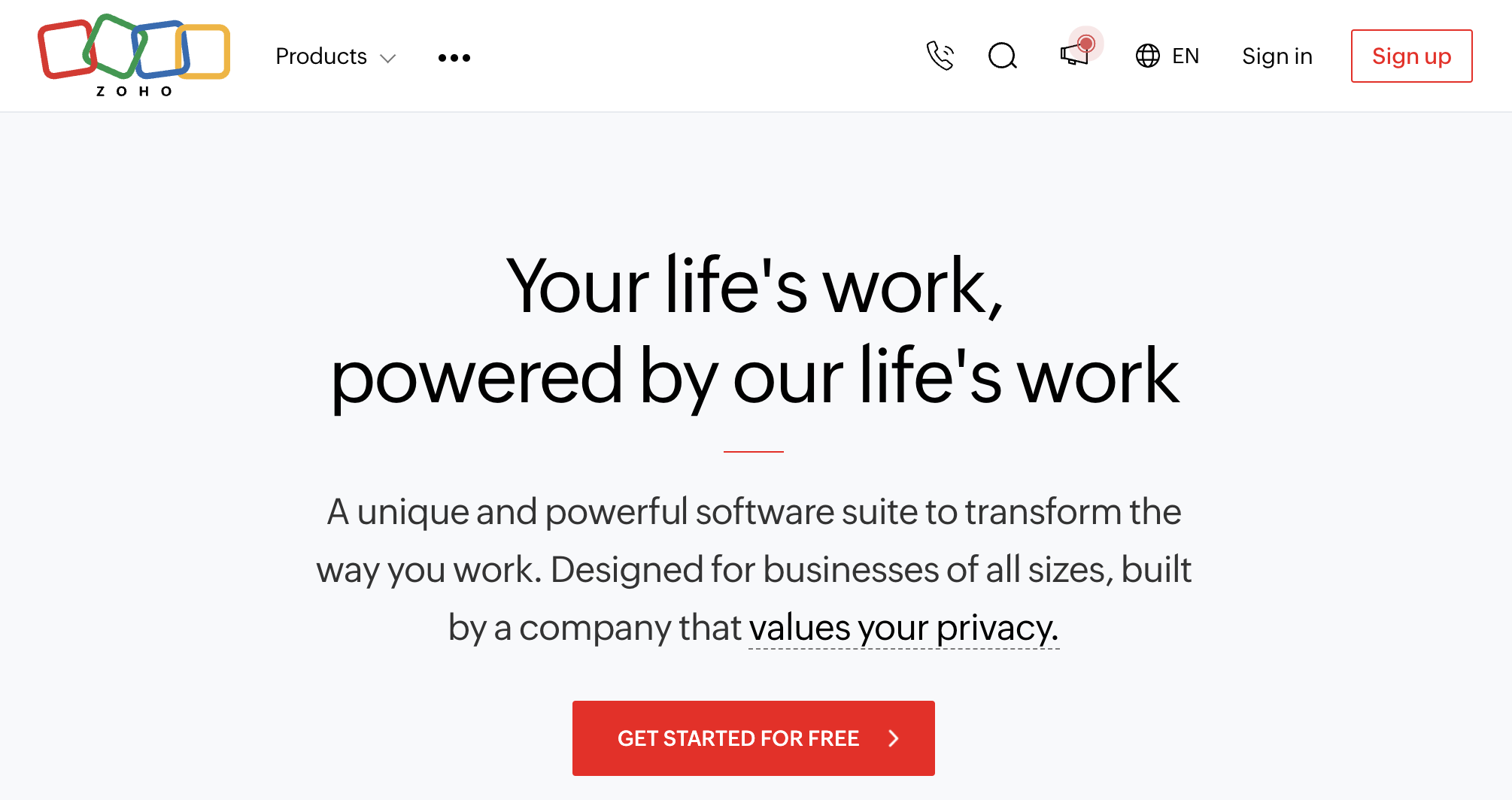 Screenshot from zoho.com, August 2024.
Screenshot from zoho.com, August 2024.Zoho Projects integrates with the Zoho ecosystem, which is ideal for SEO pros using other Zoho tools. It offers features like Gantt charts, time tracking, and issue management, which are suitable for SEO projects of any scale.
I’ve used it for a global SEO expansion. Multilingual support was vital for cross-region coordination. We leveraged milestones to track phases like multilingual keyword research and localized content launches.
Why It’s Good For SEO:
- Communication tools: Zoho Project has real-time chat and forum pages, so you can quickly and easily share information with your team.
- Timekeeping: If you bill your SEO clients by the hour, this platform is a good choice because it has excellent time-tracking functionality.
- At-a-glance-info: Zoho makes it easy to spot delays, lags, and bottlenecks.
Potential Drawbacks For SEO:
- Features can be overwhelming: Because it offers so much functionality, this PM platform may intimidate some users. It also has a steeper learning curve.
- Inflexible: It can be challenging to customize projects to your needs with this platform.
Tips and Tricks:
- Use “Task Dependencies” for proper sequencing, especially in technical SEO.
- Monitor “Resource Utilization” to balavital workload and prevent burnout.
- Use built-in chat for quick task discussions, keeping emails clutter-free.
Best Hack:
- Set up “Automation Rules” to streamline workflow. Example: Auto-assign content optimization when organic traffic dips below a set threshold (integrate with analytics for tracking).
7. Wrike
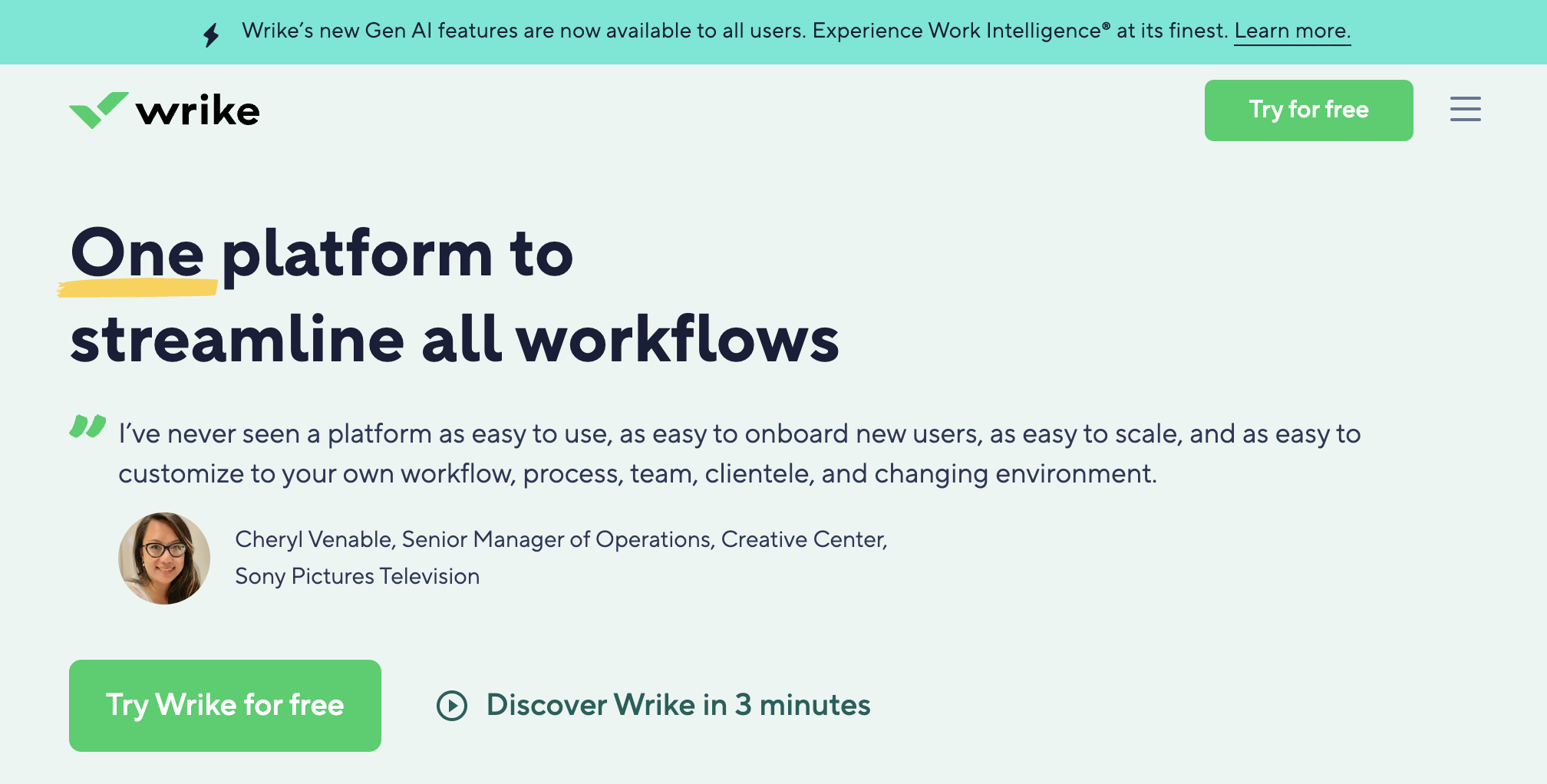 Screenshot from wrike.com, August 2024.
Screenshot from wrike.com, August 2024.Wrike is a flexible PM tool with deep customization options, which is ideal for SEO teams with unique workflows.
Its reporting and real-time updates keep stakeholders informed about SEO progress. The platform offers multiple project visualization options, including Gantt charts, workload views, and custom dashboards.
I’ve used Wrike for a large-scale e-commerce SEO audit and implementation. The custom workflow feature allowed us to track SEO fixes from discovery to completion through stages like “Issue Identified,” “Fix Proposed,” “Implementation,” and “Verification.”
Why It’s Good For SEO:
- Task prioritization: With Wrike, you can push critical tasks to the front to ensure you don’t miss deadlines.
- Natural workflow: Wrike is structured in a way most people find logical and easy to use.
- Advanced features: Functionality for task management, Gantt charts, and real-time newsfeed are built-in.
Potential Drawbacks For SEO:
- Pricier than some options: A free version with limited functionality is available, but premium plans with more functions are more expensive than other PM tools.
- Difficult onboarding new users: Adding new users and assigning tasks must be done manually, which can be time-consuming.
- Can be challenging to navigate: Users unfamiliar with Wrike may have difficulty navigating projects.
Tips and Tricks:
- Use Custom Fields for SEO metrics like SERP positions or Core Web Vitals scores.
- Monitor team capacity with Workload View, especially during algo updates.
- Leverage Wrike Analyzecreating and implementing communication plans easy
Best Hack:
- Build an SEO Health Dashboard using Wrike widgets. Integrate key metrics from your SEO stack (traffic, rankings, backlinks) for a unified performance and project data view.
8. Smartsheet
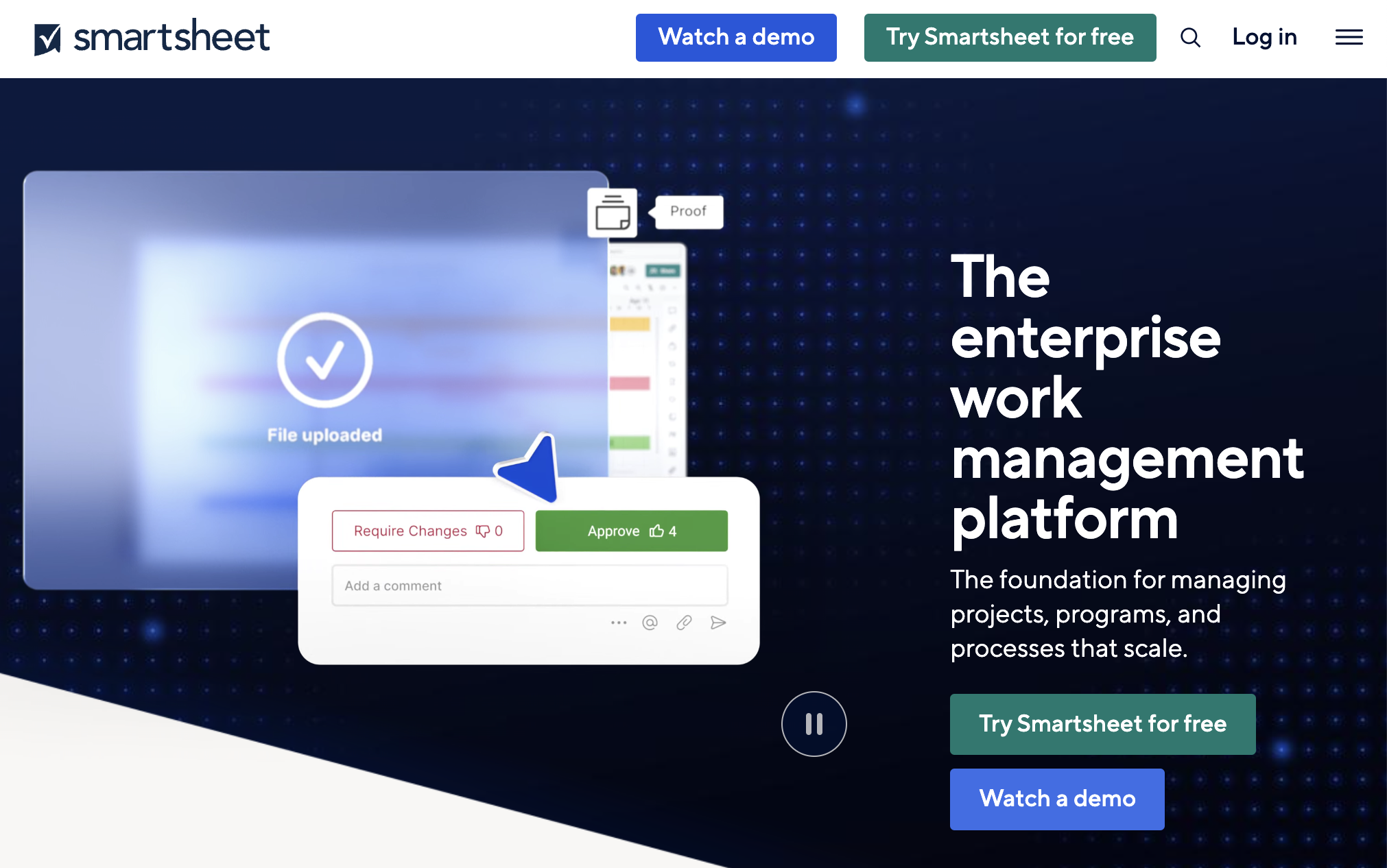 Screenshot from smartsheet.com, August 2024.
Screenshot from smartsheet.com, August 2024.Smartsheet blends spreadsheets with project management tools, which is ideal for SEOs moving from Excel. Its automation and integrations streamline workflows and consolidate data from various SEO tools.
I’ve used Smartsheet for ongoing tech SEO maintenance to track tech elements (speed, mobile, schema) across site sections. Conditional formatting flagged issues, while automated alerts notified the team of subpar metrics.
Why It’s Good For SEO:
- Robust communication and collaboration: Smartsheet makes it easy to create and implement communication plans.
- Adding tasks and dependencies: Smartsheet’s intuitive design makes it easy to add tasks and dependencies.
- Custom dashboards: Set up your dash to display the information you want.
Potential Drawbacks For SEO:
- Doesn’t support detailed documents: Users are only allowed to upload 10 documents per ticket, which can be troublesome for highly specific campaigns.
- May be too simple for larger teams: If you’re overseeing a big team with many stakeholders, you may find this platform doesn’t include all the functionality you want.
Tips and Tricks:
- Use “Cell Linking” to connect data across sheets for SEO dashboards.
- Set up “Automated Workflows” for SEO deliverable approvals and task assignments.
- Use “Gantt View” to visualize and adjust SEO project timelines.
Best Hack:
- Create a “Data Fetch” automation to pull SEO metrics from your analytics tool via API. This auto-populates key metrics like organic traffic, bounce rate, and conversion rates, allowing easy tracking of SEO impact over time without manual entry.
9. Celoxis
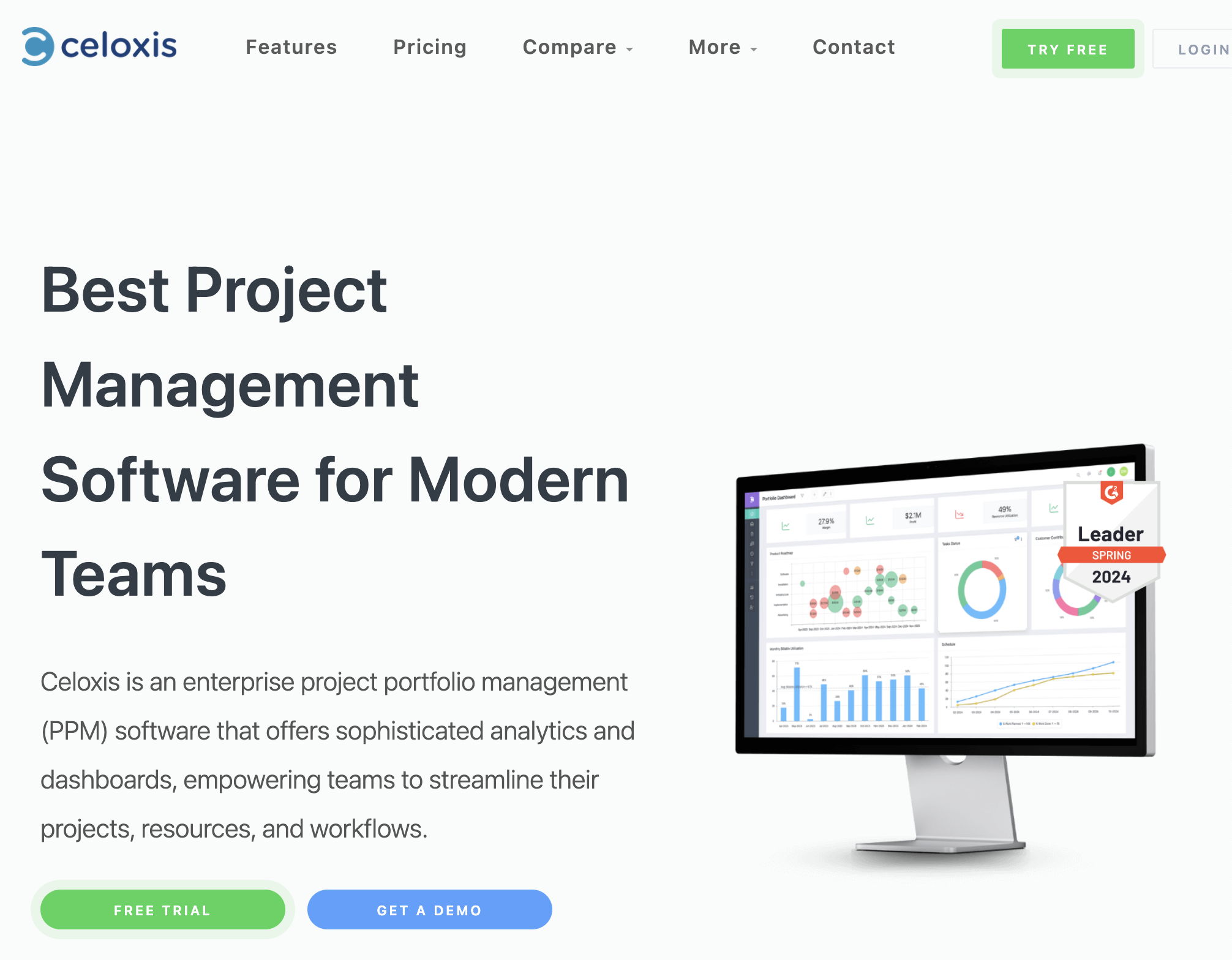 Screenshot from celoxis.com, August 2024.
Screenshot from celoxis.com, August 2024.Celoxis is a PM tool that’s ideal for complex SEO projects. It excels in resource management, financial tracking, and customizable dashboards. It’s perfect for SEO pros juggling multiple clients or large campaigns, offering granular control and big-picture views.
I’ve used it for a major e-commerce SEO campaign. Custom fields let us track keywords and rankings per task. Resource management helped balance the workload across content, tech SEO, and link-building teams, streamlining the process.
Why It’s Good For SEO:
- Easy to use: Celoxis gives you the tools to dive deep into a project without sacrificing usability. It’s also easy to set up.
- Includes time tracking, resource management, and budgeting: It also has ample reporting features to keep you on track.
- Good value: Celoxis offers the functionality of a top-tier PM platform at the price point of a mid-tier one.
Potential Drawbacks For SEO:
- No billing or invoicing functionality: You will have to use an outside program to bill your clients.
- No free version: If you’re looking for a free-to-use PM platform for your SEO team, this isn’t it.
Tips and Tricks:
- Use “What-If” analysis to model different SEO resource allocations.
- Leverage the bug tracker to manage tech SEO issues.
- Implement a client portal for transparent progress and performance sharing.
Best Hack:
- Build a custom “SEO ROI Dashboard”. Combine cost data from Celoxis with performance metrics from your analytics. This visualizes ROI across SEO activities, informing strategy decisions.
10. ProofHub
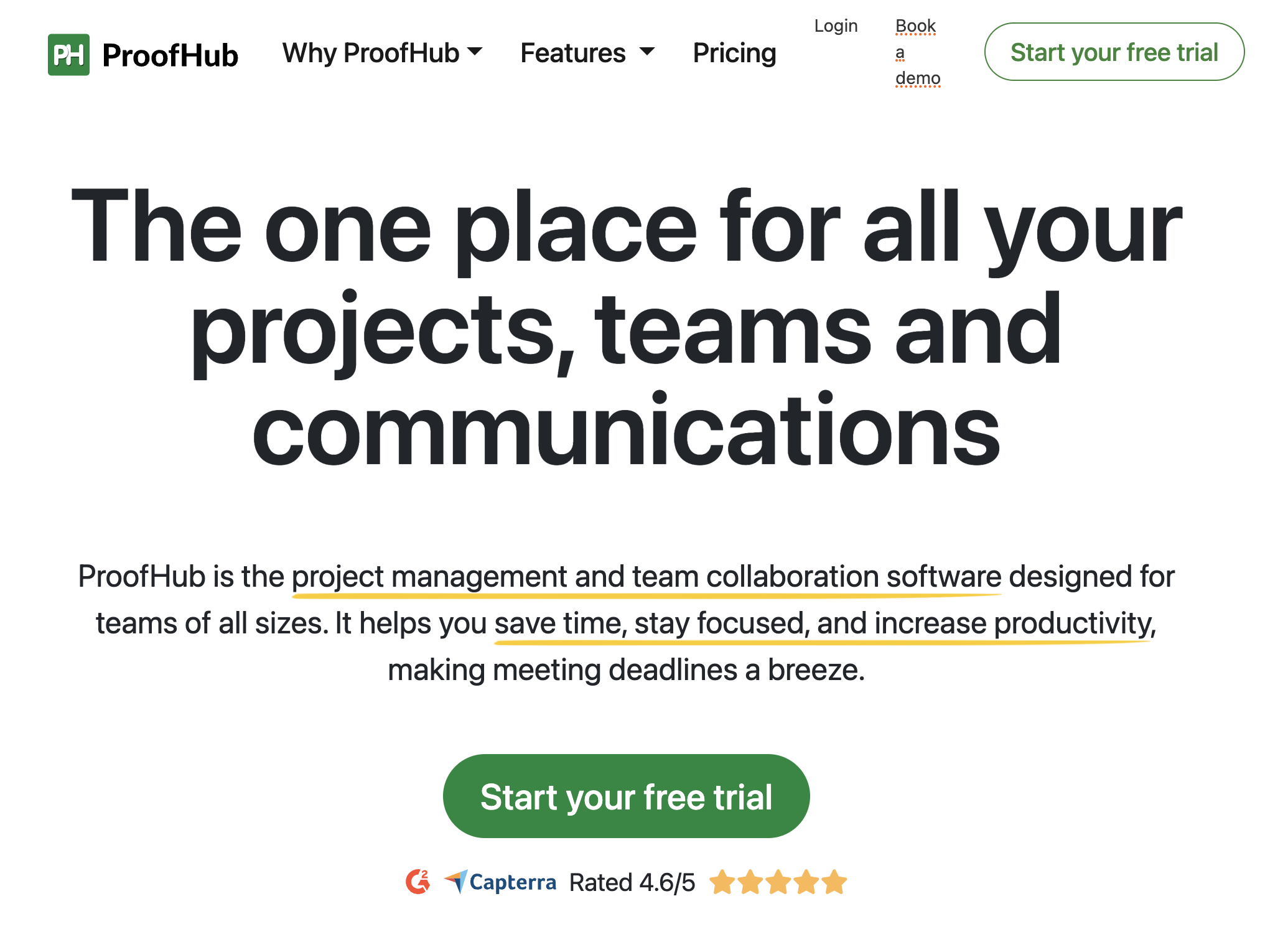 Screenshot from proofhub.com, August 2024.
Screenshot from proofhub.com, August 2024.ProofHub is a lightweight PM tool ideal for small SEO teams or those new to structured project management. It covers the basics—Kanban, Gantt, and time tracking—without feature bloat.
I’ve used it for an SEO-driven site redesign. The Kanban board was great for tracking page optimizations through the “To-Do,” “In Progress,” “SEO Review,” and “Complete” stages.
File attachments kept wireframes, content, and SEO recommendations organized within tasks.
Why It’s Good For SEO:
- All the tools you need: ProofHub gives you everything you need for SEO planning, team collaboration, and management.
- Unlimited users: You can add as many people to the platform as you need.
- Communication: Thanks to built-in chat and document-sharing features, all discussions can be centralized in one place.
Potential Drawbacks For SEO:
- Recurring tasks must be entered manually: ProofHub does not provide you with the option to repeat tasks.
- No budgeting: You will need to use a third-party platform to oversee budgeting for your SEO tasks.
Tips and Tricks:
- Use “Table View” for multi-metric tasks like content audits.
- The “Discussions” feature keeps SEO chats centralized, cutting email overload.
- “Me View” shows your assigned SEO tasks across projects.
Best Hack:
- Create a weekly recurring task for SEO health checks. Include a metric checklist (organic traffic, rankings, new backlinks) to spot trends and issues early.
11. ClickUp
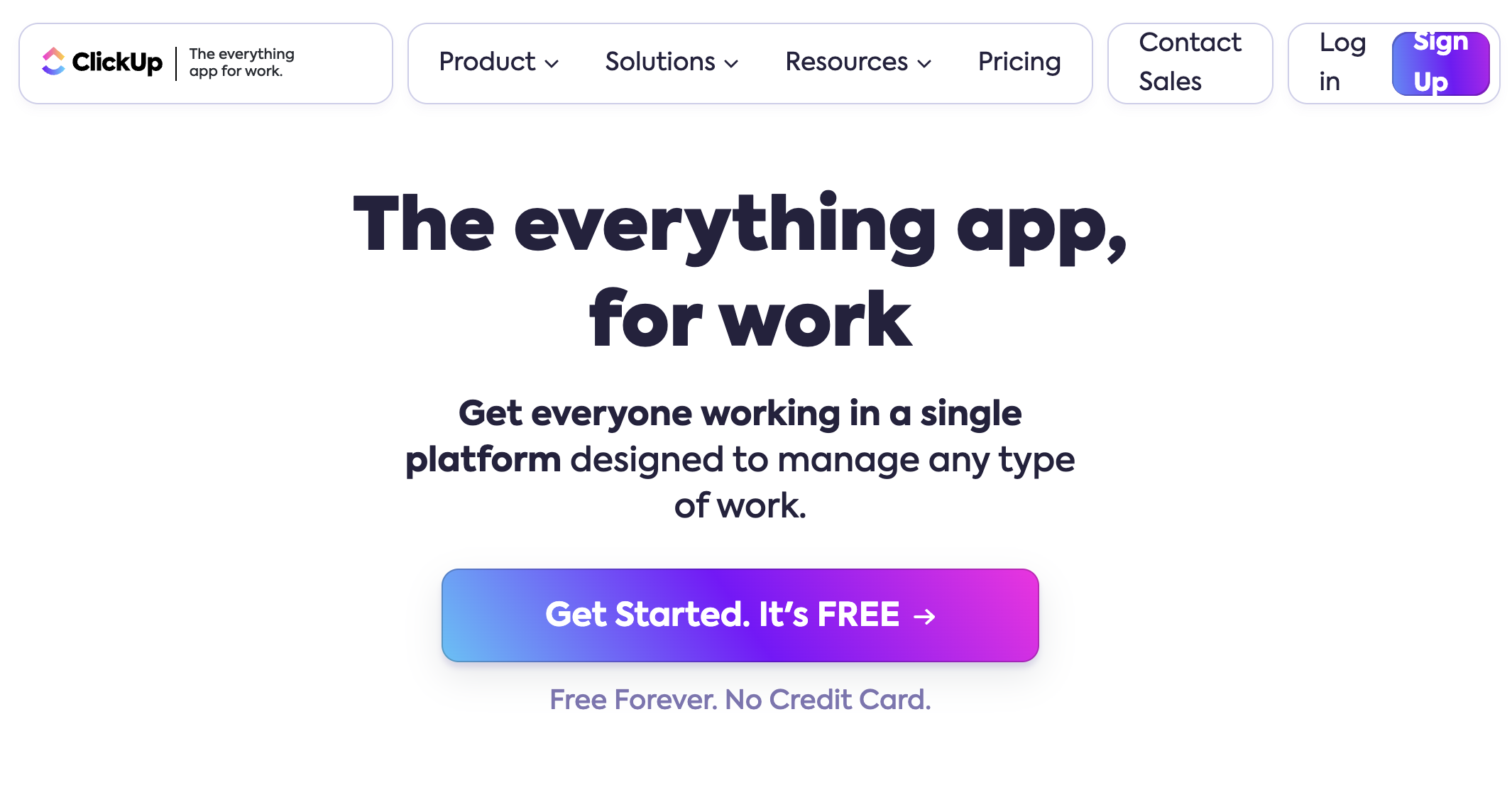 Screenshot from clickup.com, August 2024.
Screenshot from clickup.com, August 2024.ClickUp is a versatile PM tool that adapts to any SEO workflow. Its key feature is multi-view project visualization, which suits various work styles. SEO pros can manage daily tasks and long-term strategies in one place.
I’ve used ClickUp for a multi-location local SEO campaign. Custom Fields tracked Google Business Profile info, keywords, and ranking data per location. The Relationships feature linked tasks across campaign aspects, like connecting on-page and citation tasks.
Why It’s Good For SEO:
- Easy to use: ClickUp has a short learning curve, meaning you and your team can start benefiting from it faster.
- Multiple views: You can track your campaigns via a list, board, calendar, and workload view, among other options.
- Perfect balance of functions and ease of use: ClickUp falls in the Goldilocks zone by including the features you want without the complexity.
Potential Drawbacks For SEO:
- Navigation can be confusing: The differences between tabs are subtle.
- Implementation can require significant planning: Because ClickUp is highly customizable, you may have to systematically plan workflows to maximize its benefits.
Tips and Tricks:
- Use Sprints for time-bound SEO projects (e.g., site speed improvements)
- Workload view helps balance team tasks, especially during algo updates
- Automate repetitive SEO tasks (e.g., auto-generate content briefs for new keywords)
Best Hack:
- Create an SEO command center Dashboard. Use widgets to show real-time data from SEO tools (rankings, traffic, backlinks, tech SEO scores). This centralizes performance metrics alongside task management.
12. Forecast
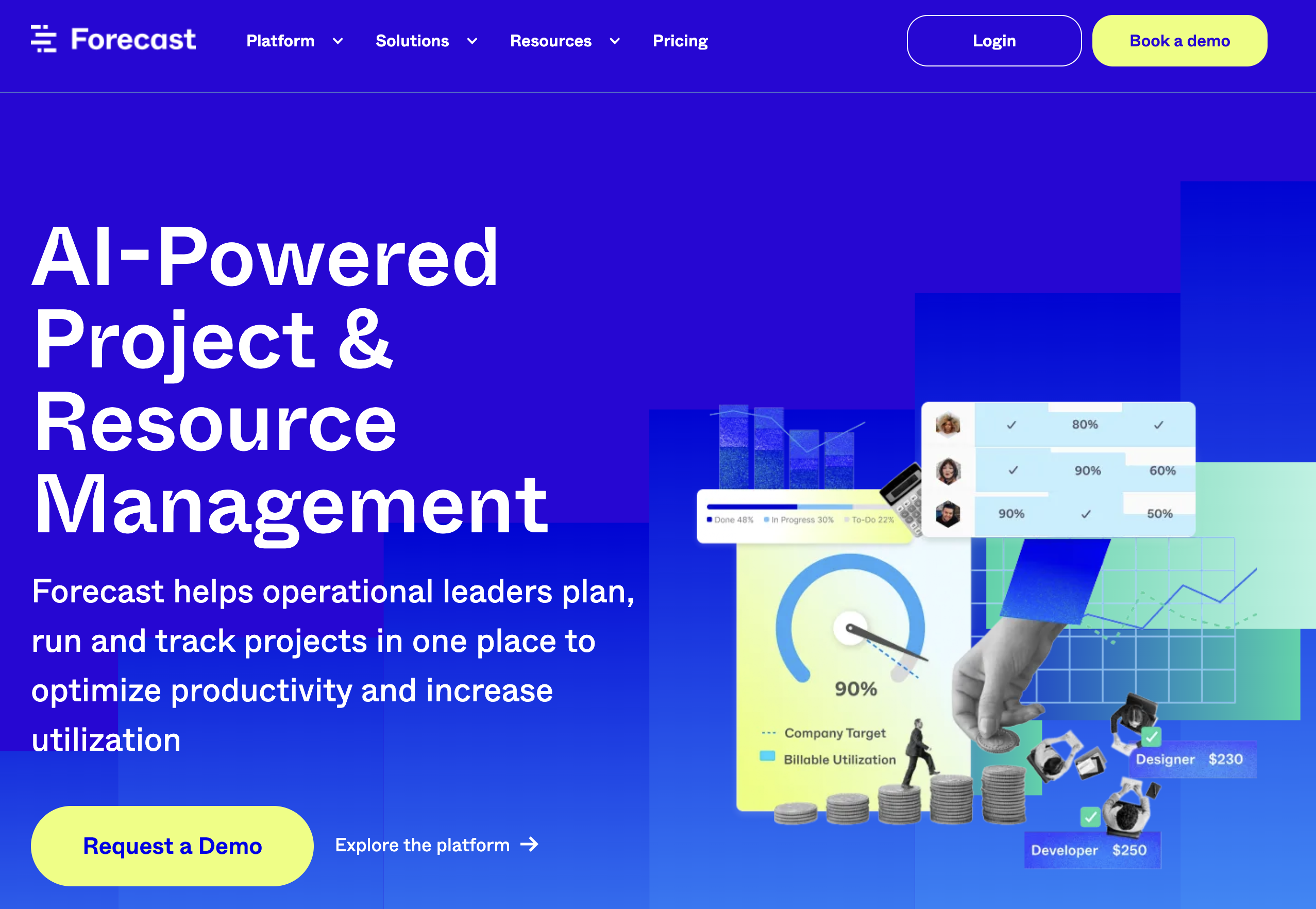 Screenshot from forecast.app, August 2024.
Screenshot from forecast.app, August 2024.Forecast is an AI-powered project management tool tailored for SEO teams. It excels in resource allocation and financial planning, making it ideal for agencies and in-house teams managing multiple SEO projects.
Key benefits:
- AI-assisted time estimation for complex SEO tasks.
- Resource management across client campaigns.
- “Insights” feature for analyzing task duration and improving estimates.
I found it valuable for estimating variable-effort tasks like content creation and link building and identifying consistently underestimated SEO activities.
Why It’s Good For SEO:
- Easily track project lifecycles: This platform allows you to assign and allocate tasks and budget for your entire SEO PM operation.
- Schedule visualization: You can get information on a team member’s workload at a glance.
- Gathering data is easy: Want to compare a current campaign to an old one? Forecast makes it easy to pull data.
Potential Drawbacks For SEO:
- Updating time and task entries can be tedious: Manual entry can be a time-consuming process.
- Not ideal for larger teams: Visualization elements can be overwhelming if you have a lot of people working under you.
Tips and Tricks:
- Use “Baseline” to track actual vs. planned progress, refining SEO estimates.
- Utilize “Skills” for optimal task allocation based on team expertise.
- Leverage financial planning to assess the profitability of SEO services/clients.
Best Hack:
- Create a custom “SEO Efficiency” report comparing estimated vs. actual time for different SEO tasks (on-page, content, link building). Use insights to optimize team efficiency and processes.
13. Adobe Workfront
 Screenshot from business.adobe.com/products/workfront/main.html, August 2024.
Screenshot from business.adobe.com/products/workfront/main.html, August 2024.Adobe Workfront is a high-end project management tool for big SEO teams or agencies. It shines in managing complex SEO campaigns with intricate workflows and integrates well with other Adobe products.
I’ve used Workfront for a multi-brand SEO and content marketing project. Its custom forms were great for SEO tasks like tech audits and link building. The portfolio management helped track progress and ROI across brands.
Why It’s Good For SEO:
- Well-designed user interface: Workfront is easy to use and visually appealing.
- Real-time information: It keeps you abreast of any status changes.
- Good transparency: This platform helps eliminate confusion about who is supposed to do what, as stakeholders and project scope are easily visible.
Potential Drawbacks For SEO:
- Lengthy setup process: A high level of customization means Workfront requires a more in-depth initial setup.
- May offer too much detail: With Workfront, you can get as granular into tasks as you like, which may lead to some people becoming lost in the details.
- Finding tasks can be difficult: If you don’t know what project a task is assigned to, it can be difficult to locate.
Tips and Tricks:
- Use Workfront Fusion for SEO tool integrations and workflow automation.
- Utilize Resource Planner for SEO team allocation across projects.
- Create custom dashboards combining project progress and SEO metrics.
Best Hack:
- Set up an “SEO Impact” field with automated task prioritization. For example, high-impact tasks like page speed improvements for key pages get auto-flagged as high priorities, keeping crucial SEO work at the forefront.
14. WorkOtter
 Screenshot from workotter.com, August 2024.
Screenshot from workotter.com, August 2024.WorkOtter is a solid, user-friendly project management tool that’s great for SEO teams. It shines in resource management and reporting, making it ideal for agencies or in-house teams juggling multiple SEO projects.
From experience, its standout features for SEO include:
- Efficient resource allocation across specialists, writers, and devs.
- Customizable dashboards for client-specific “SEO Health” metrics.
- Detailed tracking of organic traffic, keyword rankings, and backlink growth.
It’s powerful enough for complex SEO work without being overly complicated.
Why It’s Good For SEO:
- Very easy to use: You don’t have to be a tech wiz to use WorkOtter for SEO project management.
- Good communication and reporting tools: Real-time information keeps your entire team on the same page.
- Good for resource management: This platform helps decide exactly where your SEO resources will be allocated.
Potential Drawbacks For SEO:
- Cloud-only: There is no local version available, which can be problematic if you are trying to work offline.
- English-only support: This may present challenges for non-native English speakers.
Tips and Tricks:
- Use “Capacity Planning” to manage team workload during busy periods (e.g., algorithm updates, peak seasons).
- Leverage “Project Templates” for standardizing everyday SEO tasks.
- Track time accurately with “Time Entry” for better project estimations.
Best Hack:
- Create a custom “SEO Project Scorecard” using WorkOtter’s reporting tools. Score projects based on the following:
- SEO metrics (traffic growth, rankings, page speed)
- PM factors (timeliness, budget)
This scorecard helps quickly gauge project health and pinpoint areas needing focus.
15. PSOHub
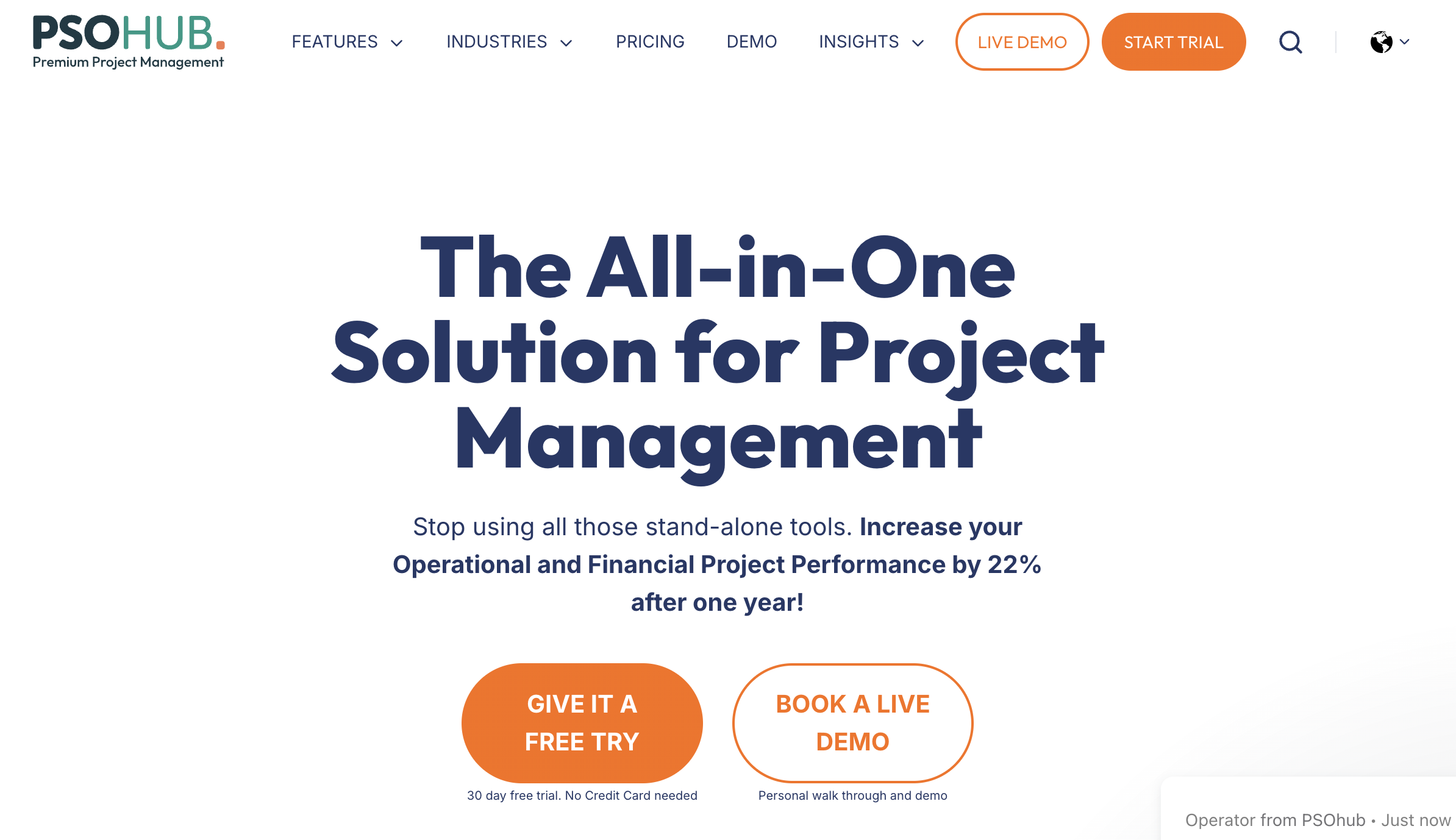 Screenshot from psohub.com, August 2024.
Screenshot from psohub.com, August 2024.PSOHub is a project management tool for service-based businesses, including SEO agencies. It integrates time tracking, invoicing, and resource management. SEO pros can handle project management, billable hours, and client invoicing in one place.
From experience, PSOHub’s project budgeting feature is handy for SEO work. You can set budgets for various SEO tasks (tech SEO, content, link building) and track hours/costs against them. Auto-invoicing based on logged hours streamlines billing, ensuring all SEO work is captured.
Why It’s Good For SEO:
- Excellent time tracking functionality: PSOHub is one of the best platforms for tracking where your team’s time is being spent on both group and individual levels.
- CRM integrations: This platform integrates with Hubspot and other CRMs, so you can track your SEO campaigns alongside email initiatives.
- Flexible reporting: PSOHub lets you choose the data you want to include in reports.
Potential Drawbacks For SEO:
- Time-consuming setup process: It can take some time to manually enter all your campaigns and tasks into this platform.
- All users must have the same license level: You cannot have some users on a basic level and others on a more complex one.
Tips and Tricks:
- Use “Resource Scheduling” to efficiently plan the SEO team’s time across client projects.
- Utilize “Project Templates” for SEO services like site audits or local SEO campaigns.
- Use CRM integration to link SEO project data with client info for a complete view.
Best Hack:
- Create custom “SEO Service Packages” in PSOHub. Set up preset task groups, estimated hours, and costs for standard SEO services (e.g., Tech SEO Audit, Content Optimization, Local SEO Bundle). This speeds up project setup and helps generate quick, accurate client quotes.
In Conclusion
Choosing the right project management tool can boost your SEO team’s performance. But with so many options, how do you pick the best one? Here are some things to think about:
Team Size:
- Small teams: Try simple tools like Trello or ClickUp.
- Medium teams: Asana or Monday might work well.
- Big teams or agencies: Look at heavy-duty options like Adobe Workfront or Smartsheet.
Project Complexity:
- Basic SEO work: Trello’s board-style setup could be enough.
- More involved SEO plans: Try tools with timeline views and resource tracking like GanttPro or Teamwork.
- Complex, multi-client SEO: Go for all-in-one solutions like Wrike or Celoxis.
SEO-Specific Stuff:
- Need to track SEO metrics closely? PSOHub or Forecast lets you customize fields and connect with other tools.
- Doing lots of content work? Asana or ClickUp are good for managing content projects.
- Focusing on technical SEO? Jira or Celoxis is great for tracking bugs and technical tasks.
Budget:
- Free options: Trello and Asana have decent free versions for small teams.
- Mid-range: Monday and ClickUp give you a good bang for your buck.
- High-end: Workfront and Smartsheet offer advanced features if you can spend more.
Connecting with Other Tools:
- Using many different tools? Look for options that integrate well with others, like Asana or anything that works with Zapier.
- Use Adobe products? Adobe Workfront fits right in.
- Are you already using Zoho? Zoho Projects naturally fits with other Zoho tools.
Remember, the best tool is one your team will use consistently. Try out your top picks before deciding. Get your team involved in choosing – it’ll make switching to the new tool easier.
And remember, as your team grows and changes, your needs might too. Keep an eye out for new tools that might improve your SEO workflow.
More resources:
Featured Image: RerF_Studio/Shutterstock
Nguồn: Searchenginejournal
